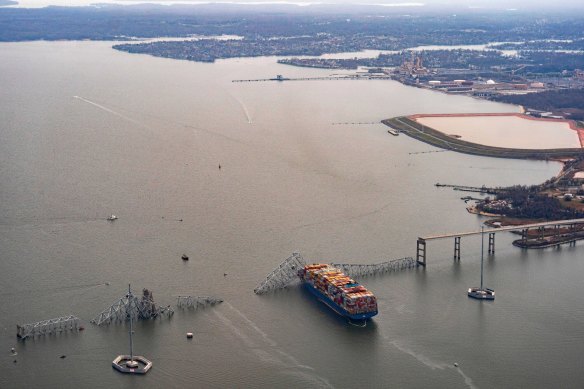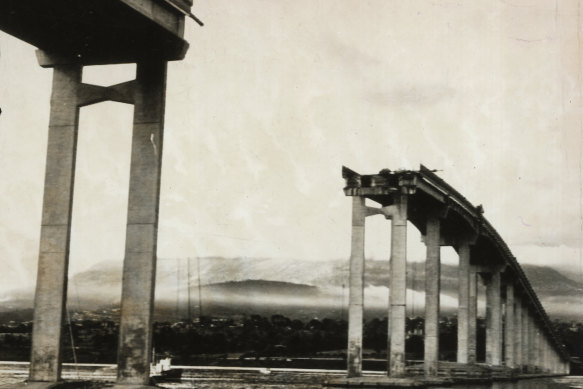By Angus Dalton
The great bridge that spans Sydney Harbour has become the soul of the city’s silhouette, seemingly as immovable as the sandstone cliffs of the city’s Heads.
But the illusion of such infrastructure’s permanency came crashing down overnight when a container ship struck the pylon of the Francis Scott Key Bridge in Baltimore with devastating results. The entire structure, along with a construction crew and several vehicles, plunged into the Patapsco River.

The Dali container vessel after striking the Francis Scott Key Bridge that collapsed into the Patapsco River in Baltimore.Credit: Bloomberg
The scenes rattled a city that has at least 250,000 people cross the Sydney Harbour Bridge each day; not to mention other harbour crossings including the Anzac, Pyrmont and Gladesville bridges.
“The lesson here is that we have to be vigilant,” Associate Professor Colin Caprani, a bridge engineering expert at Monash University, said. “We can’t just take the infrastructure that’s out there and say, ‘Look, it’s fine,’ especially when ships get bigger, trucks get heavier, when the factors that [bridges] are exposed to are changing.”
Key protective measures of the Francis Scott Key Bridge failed.
Large concrete structures called “dolphins” were set about 100 metres away from the bridge to stop any ships from smashing into the pylons, for example.
“It’s a bit like a crash barrier. It’s designed to absorb lots and lots of energy, through deformation and by breaking up itself. It’s a sacrificial piece,” Caprani said. “This ship seemed to completely avoid the dolphin.”
A second layer of pylon defence called a fender, made of reinforced concrete, was also meant to protect the base of the bridge’s piers.
“The fender in this instance just was not capable of resisting this ship’s impact. This fender was built in the ’70s … the ships back then were a lot smaller than they are now.”
Australian standards require engineers to design bridges for the largest ship envisaged over the next 100 years.

The Tasman Bridge in Hobart after it was struck by the Lake Illawarra container ship in 1975.Credit: Fairfax Archive
“But we can only take into account the foreseeable future, right? Could people have known that ships would get three or four times bigger since the ’70s? That’s a little bit debatable.”
About 40 ship strikes have damaged bridges globally since the 1960s, including a deadly Australian disaster almost 50 years ago.
In January 1975, the Lake Illawarra bulk carrier smashed into two pylons of the Tasman Bridge in Hobart. A large chunk of the road deck crashed into the river and onto the ship, killing seven crew members and four people who were on the bridge. Now road traffic stops when large vessels pass under the rebuilt bridge.
The tragedy also led to an overhaul of worldwide regulations involving bridge engineering and shipping. But the reform came after construction of the Francis Scott Key Bridge started in 1972.
Caprani said it would be nearly impossible for a catastrophe similar to the Baltimore bridge collapse to unfold in Sydney Harbour.
Professor Wije “Ari” Ariyaratne, the man who for almost two decades managed the potential risks threatening the 6000 bridges in NSW, said any ship headed for the Harbour Bridge pylons would probably run aground before inflicting damage.
“We don’t have a pier in the middle of the channel,” said Ariyaratne, the state’s director of bridges and structures between 2000 and 2019. “Bradfield made a two-pier arch and the bearings for the two piers are located on land. We in Sydney are very lucky. We have got very strong sandstone that anchors the bridge.”
Ariyaratne urged authorities to audit the state’s bridges and decide if any work was required to strengthen pylons or add shock-absorbing fenders.
“Are there any bridges with piers in river channels, streams or in the ocean? What is the growth of the vessels going under each bridge since it was designed? Do the piers have capacity [to withstand] ship impacts?”
Thanks to the harbour’s geography, the bridges that service Sydney needn’t be as long as the Francis Scott Key, which is twice as long as the Sydney Harbour Bridge and hence required the water-based pylons.
“There are not too many container ships going to the Parramatta River, under the Harbour Bridge,” Professor David Levinson, a transport and shipping expert from the University of Sydney, said.
“But we still send cruise ships under there and those are pretty massive. Are there ways of ensuring there’s better supports, better defence, for the supports on bridges?”
The hypothetical risk would be an oversize cruise ship trying to pass under the bridge for White Bay rather than pulling into the Overseas Passenger Terminal at Circular Quay. Many large cruise ships are 60 metres tall and the largest reach heights of 73 metres. The shipping clearance level for the bridge is 49 metres.
At the end of 2022, Princess Cruises’ Pacific Adventure became one of the tallest ships to pass under the bridge, coming within metres of the road deck’s underside.
“If a cruise ship was to hit the road deck on the Harbour Bridge, I’d expect significant damage,” Caprani said.
“But I don’t think the bridge necessarily would come down because the arch itself is the main structural element and that is a lot higher than the road deck.”
The safety of the ships in the harbour should be a continuing consideration as we enter the era of autonomous shipping, Levinson said, which leaves vessels at risk of hacks.
“You can try to enforce things with policy, but ultimately, you might need some physical designs and infrastructure to protect things from bad actors,” he said.